The regional project, "Reducing the dependence on the utilisation of trash fish/ low value fish as feed for aquaculture of marine finfish in the Asian region", is being implemented in China, Indonesia, Thailand and Viet Nam under the auspices of the Technical Cooperation Programm (TCP) of the FAO of the UN. The Lead Technical Officer for the project from FAO is Dr Mohammad Hasan, Fishery Resources Officer, FIRA, Department of Fisheries and Aquaculture of the FAO.
The regional activities are coordinated by the Network of Aquaculture Centrees in Asia-Pacific, headed by Professor Sena S De Silva. The article has been prepared based on the contribution from the country national project coordinators and has been edited by Mohammad Hasan and Sena S De Silva.
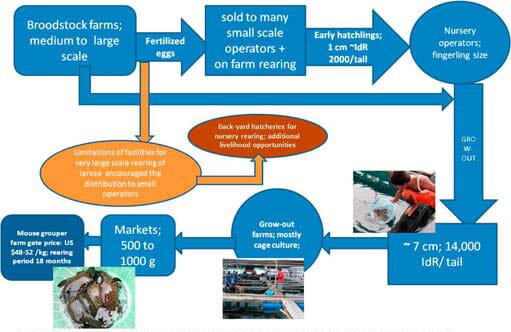
In contrast to most aquaculture practices, there is a steady increase in the diversity of marine finfish species farmed in the Asia-Pacific region. In the last two decades there have been a strong demand for high-value live reef fish in Asia, particularly by the live food fish restaurant trade (LFFRT) in China, Hong Kong, Singapore and Taiwan Province of China and also the rest of Southeast Asia, driven by improved economic conditions. Marine fish cage culture is now replacing capture fisheries for much sought after reef fish species, such as groupers, snappers and wrasses. Also the capture fisheries of such species tended to use destructive fishing gears, and this together with increasing fuel costs have resulted in a decline, and also a general reluctance of the public, to consume wild caught reef fishes.
In the early stages of the farming of important reef food fishes there was a high degree of dependence on wild caught seed. The supply of wild caught seed for cage culture, which also involves destructive fishing practices and quarantine risks makes it neither reliable in quantity nor quality. Closing the life cycle of some of the important farmed species, and the commercialisation of these practices, has gradually led to a very significant increase in the use of such seed stocks in the farming practices in the region. Some of the important species, the farming of which are based on hatchery reared seed stocks, albeit to varying degrees, are orange-spotted grouper (Epinephelus coioides), Malabar grouper (E. malabaricus), humpback grouper (Cromileptes altivelis), giant grouper (E. lanceolatus), tiger or brown-marbled grouper (E. fuscoguttatus), seabass (Lates calcarifer), snubnose pompano (Trachinotus blochii), Russell’s snapper (Lutjanus russellii), and cobia (Rachycentron canadum).
On the other hand, marine finfish farming is still predominantly dependent on the direct use of trash fish/low-value fish, and remains a contentious issue on many grounds such as resource use, environmental pollution, irregular supply, poor feed conversion efficiency (high FCR) and energy/oil costs for capture. The ongoing FAO/NACA project on “Reducing the dependence on the utilisation of trash fish/ low value fish as feed for aquaculture of marine finfish in the Asian region” is expected to address these issues through a direct involvement of farmers in reducing the perception that the trash fish/low value fish perform better than pellet feeds. It is expected that the farmer based trials will lead to a transition phase from the use of one feed form to the other, and consequently contribute to overall sustainability of this sector in Asia, and preservation of the livelihoods of the farmers and trash fish suppliers. Indeed, the project will attempt to address whether the use of trash fish/ low-value fish directly as a feed is more detrimental than the use of commercial feeds. Accordingly, participatory trials for comparisons between commercial pellet feeds and trash fish in marine fish cage culture are being conducted in Zhanjiang, Guangdong Province in China; Lampung in Indonesia; Phuket, Phang-nga and Krabi provinces in Thailand and; Nha Trang, Khan Hoa Province in Viet Nam, supplemented with relevant livelihood surveys of fish farmers and trash/ low value fish suppliers.
This presentation is the first of a series, and attempts to evaluate the current mariculture practices in operation in the four countries participating in this project.
Marine fish culture operations in Asia
The marine finfish production in these four major producing countries dealt with here have significantly increased over the years and currently accounts for 394,580 tonnes, valued at nearly US$ 512 million, with China being the largest producer. The above production however, is achieved mostly through small, farmer owned / leased, operated and managed practices, as in most aquaculture practices in the Asia-Pacific region.
In Asia, there has been a considerable development of smallscale or backyard hatcheries for marine finfish species, as is the case for shrimp, that have only a couple of larval rearing tanks. These hatcheries use simple but effective technologies to produce seedstock of a range of marine finfish species for cage culture. The key for commercially successful hatcheries in Taiwan Province of China is to share the fertilised eggs among the small-scale hatcheries for mutual benefit. As grouper species usually spawn over a million eggs at any one time, it is often difficult for a hatchery to complete the larval rearing cycle by self due to a strong demand for live feed production, space and other facilities and intensive requirement of skilled labour in nursery rearing. Often the spawning time and frequency is unpredictable, and therefore mass production of live feed such as rotifer, Chlorella, Tetraselmis etc. for feeding hatchlings for one or more spawns at a time is often difficult. This small-scale model is similar to the grouper network developed by NACA which is now developing in ASEAN countries particularly in Indonesia and Thailand. The simplified and inexpensive technology of small-scale hatcheries also minimises the risk on heavy mortality caused by disease transmission, poor management by unskilled workers and other physical factors (e.g. power disruptions, shortage of feed and other supplies).
Table 1. Aquaculture productions and values of economically important marine fish in 2007 (FAO, 2009).
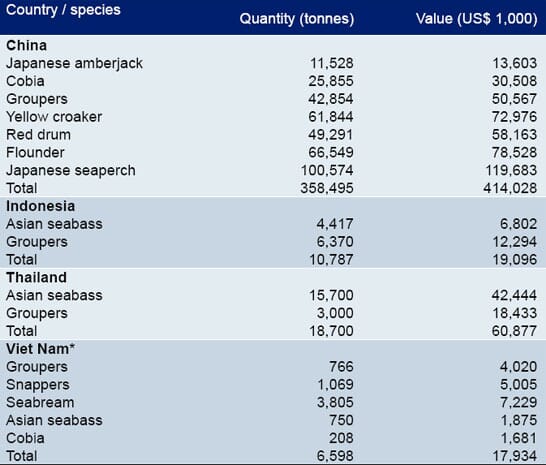
In China, medium-scale hatcheries are found mainly in Hainan Island while large-scale enterprises are found on mainland. Most farms are small to medium scale (10-100 cages per farm) with increasingly developed large-scale offshore cages. Traditional cages were generally developed from small-scale operations (4-20 cages) and subsequently expanded to medium size (20-100 cages) until becoming crowded and hence there are limitations of suitable space for operations.
Over 80per cent of hatcheries in Indonesia, particularly in Bali are small-scale. Fertilised eggs are produced by large-scale hatcheries that maintain broodstock and distribute eggs to many small-scale hatcheries for larval rearing and nursing using simple technology. Such small-scale hatcheries also have the capability to switch production between species such as for example between mouse grouper, tiger grouper, milkfish and shrimp depending on price and demand. Grow-out operations in cages in Indonesia is generally more medium-scale (20-100 cages) than small-scale (less than 20 cages) and large-scale (over 100 cages). As an island country, investment on cage farming is high due to requirements for more rigid structures suitable for deep water but the water quality is excellent.
Commercial seabass hatcheries in Thailand also supply fertilised eggs to small-scale hatcheries for similar reasons as above. In Thailand, small-scale or backyard hatcheries also engage in nursing of 1 cm Asian seabass fry produced from hatcheries, or wild caught grouper fry up to stocking size for cage culture. These operations are also capable of shifting between species, ranging from marine shrimp, freshwater prawn, seabass, grouper, etc. according to price and market demand, which is strong evidence of the resilience of these small-scale operators to meet the challenges of the market fluctuations. Cage culture in Thailand is mainly a small-scale operation which is commonly located inshore or in mangrove creeks, not far from farmers’ houses for easy management by owners, security and saving of labour costs. Other advantages are that these offer convenient sites, savings on transportation and less mortality for partial harvest and supply to live fish markets in the main cities and tourist spots. Over 80per cent of marine cages are small-scale (4-20 cages) while the rest are medium-scale (20-100 cages). Large-scale cage culture is always limited by insufficient fingerling supplies, irregular demand of the domestic live fish market and unreliable export markets. Many small-scale farmers also use gill nets to trap small fish to feed their farmed stock in order to reduce costs.
Over 30,000 small-scale cages have been reported in Viet Nam, with many in Halong Bay where they are well protected by strong winds and wave action. In the middle of the country, cages are more medium-scale which requires more investment for rigid structure against typhoons and storms.
There is evidence to suggest that small-scale operations run by owners / family for both hatchery and cage culture, are more suitable under the prevailing conditions than large-scale enterprises which are operated by paid workers. When problems occur, production can be discontinued, even for a long period without much economic suffering. Such family businesses are in contrast to large-scale, sophisticated operations, in which the cost of wages, power, supporting facilities and other overheads such as interest on bank loans, still has to be borne during closure periods. Periodic discontinuation of operations is, in fact, necessary for aquaculture in order to facilitate reconditioning, drying and disinfection of tanks, aeration and water system as well as outbreak of disease cycle in grow-out cages. In essence the above observations on marine finfish culture are very similar to that reported for shrimp culture in the region.
Culture practices in China
Since the late 1980s, Chinese mariculture has been growing very rapidly with a large increase in species and expansion of culture areas due to the government’s open economic policy. Over one million traditional (mostly wooden) cages still account for the majority of marine cages along coastal provinces, e.g. Fujian (54per cent), Guangdong (15per cent), Zhejiang (10per cent), Shandong (7per cent), Hainan (5per cent) and others (9per cent). These traditional cages are small to medium-scale with a simple design (3-5m x 3-5m with 4-5m depth), made of locally available materials for the frame (bamboo, wooden board, steel pipe) and for fl oats (plastic container or drum and polyurethane foam) similar to other Asian countries. Cages are connected together to form a large floating raft in order to reduce the effects of wave action and strong currents. Cage rafts are commonly equipped with a mincer, high pressure pump, freshwater pipe, electricity and accommodation facilities for owner and workers.
Inshore (traditional) cage culture has been facing constraints, particularly in areas most conducive for cage culture, with good water exchange and easy access to services, due to limitations on suitable areas for expansion, typhoons, environmental pollution and disease outbreaks. Self pollution caused by accumulation of metabolites of fish and feed waste in crowded cage areas, leads to eutrophication and disease outbreaks. Therefore, offshore typhoon resistant cages are being developed to solve the above problems and to create new job opportunities for thousands of fishers who can no longer survive through fishing. The Chinese government and the relevant authorities strongly support this development both through policy and financing. Since the late 1990s, offshore cages from Norway, USA, Japan have been introduced and modified to suit local conditions and the economic situation in China.
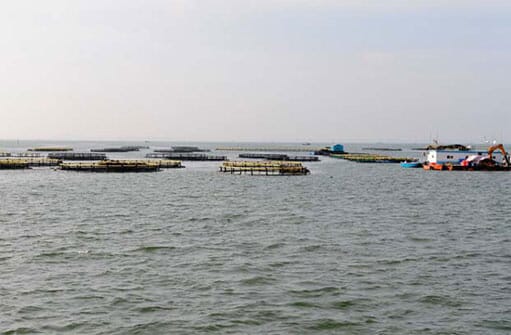
Accordingly, large floating and submersible circular cages made of high-density polyethylene (HDPE) are now locally produced at a very cheap price (less than US$ 15 per m3). Circular cages generally withstand the rough sea conditions better because the HDPE frame is more flexible than wooden and or metal frames. It can be submerged up to 4-10 m below the sea surface within 8-15 minutes if typhoon conditions prevail. Due to higher stocking density and production, farmers are able to maintain economic viability even though the profit margin is less. The reduction in sale price of the fish also attracts more consumers in both domestic and potential export markets. However, the expansion of offshore cage culture is also limited by the availability of hatchery bred seed stocks because the demand of fingerlings for stocking per cage is much higher than traditional inshore cages. The feed cost is still high because suitable pellet specific for different fish species has not yet been developed. There is also likely occurrence of high feed loss through the net in strong current conditions of deep sea for slow feeding species like grouper. The common species for stocking in offshore circular cages are cobia and giant grouper which are fast growing hatchery bred species.
Table 2. A comparison of a number of relevant parameters between inshore (traditional) and offshore cages (Chen et al., 2006).

As China has a large marine area covering both temperate and subtropical waters, there are more than 65 species that are being cultured, but these are in different stages of development. In south-east China, the large yellow croaker (Pseudosciaena crocea), groupers and cobia (Rachycentron canadum) are the most important cultured species, while Japanese flouder (Paralichthys olivaceus) dominates in the northeast. On the other hand, the Japanese seaperch (Lateolabrax japonicus) and red seabream (Pagrosomus major) are important to both regions. A few species have also been introduced and include red drum (Sciaenops ocellatus) from the US and turbot (Scophthalmus maximus) from Europe. Those species except groupers are commonly bred in commercial hatcheries. The high valued grouper species which have been successfully bred in hatcheries, include Hong Kong grouper (E. akaara), yellow grouper (E. awoara), orange-spotted grouper, Malabar grouper but the volume of seed produced by hatcheries in Hainan, Fijian, Guangzhou (Daya Bay), etc, has not been able to meet the demand for seed stock for cage culture. Traditionally, fish are fed with minced trash fish/low valued fish as much as 3per cent to 5per cent biomass daily. Trash fish is sourced from deep sea trawlers. Trash fish/low valued fish prices vary from US$ 0.20 to 0.53/kg and is not fresh as in other countries. Generally, there is a shortage of trash fish/low valued fish during summer and winter. Therefore some farmers buy commercial fish powder, starch, corn, soybean, wheat and other ingredients and mix it with fish oil, water and vitamins to produce a farm made feed.
Table 3. Summary of practices of marine fish cage culture in China (SD - stocking density; HS - harvest size; CP - culture period; FGP - farm gate price).

There are four main types of feed in use including trash fish, moist diets, farm made feeds and artificial diets. There have been many locally produced formulated feeds for common marine fish but the results for grouper culture show that they are not as efficient or economic as trash fish. Though farmers have accepted these feeds (US$ 0.75-0.85/kg) for cobia, pompano and seabream culture, the FCRs are still high. The daily feed ration for marine fish depends on ambient water temperatures. In winter and spring, it is generally reduced by 2-3 times than in summer and autumn.
Culture practices in Indonesia
Indonesia has a major development potential due to its vast potential areas, mostly inshore sheltered bays etc. for mariculture. Production of the high value species makes a significant contribution to export earnings, domestic food supply and aquatic resources conservation. Mariculture, brackishwater pond culture, freshwater pond culture, cage culture, culture in floating net cages and paddy field culture accounted for 20.0, 41.0, 22.9, 3.3, 4.7 and 7.7 percent, respectively of the total aquaculture production in the country. Grouper and other high valued marine carnivorous species contributed much to this increase in aquaculture production.
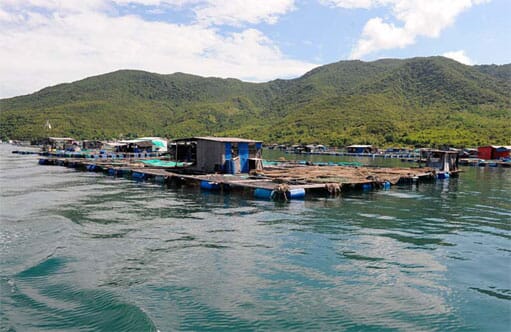
There are a number of marine fish species widely cultured in cages such as mouse or humpback grouper (Cromileptes altivelis), tiger grouper, Asian seabass (Lates calcarifer), primarily driven by the commercial success in artificial breeding of such species in Lampung and Gondol (Bali) hatcheries, followed by uptake of the technologies by private hatchery operators. Mouse grouper fingerlings of are also valued in the marine ornamental trade which is commonly exported to USA, EU, Singapore, Hong Kong and China. Recently, leopard coral trout (Plectropomus leopardus), giant grouper, orange-spotted grouper, camouflage grouper (E. polyphekadion), pompano, Napoleon wrasse (Cheilinus undulatus)- a CITES listed species , and golden trevally (Gnathanodon speciosus) have also been produced in government hatcheries and growout trials for these species are being conducted by Indonesian fish farmers.
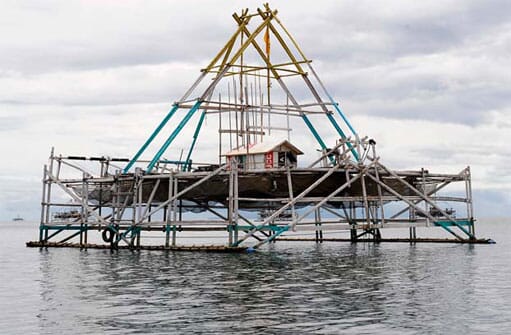
Over 125 marine fi nfish hatcheries are now operating in Bali, Lampung and East Java. These hatcheries have the capability to switch to species depending on market demand, such as in the case of milkfish and mouse grouper. However, still the culture of orange spotted grouper, Malabar grouper, dusky tail grouper (E. bleekeri), red snapper (L. argentimaculatus), rabbit fish (Siganus spp.) is mostly dependent on wild seed stocks, collected in Sumatra, Java and Sulawesi.
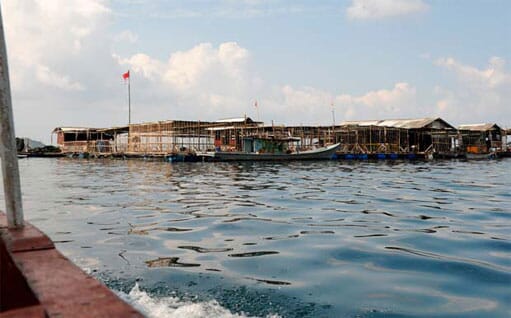
Marine fish cage culture in Indonesia is carried out in many areas as there are several well sheltered bays and water quality is generally good compared to other countries in Asia. Cage culture can be found throughout Indonesia, including the islands of Sumatra, Bangka, Bengkulu, Lampung, Kepulauan, Seribu, Banten, Java, Lombok, Kalimantan and Sulawesi. Most cage farms in Lampung are relatively medium and large-scale operations (80-120 cages) and well constructed with wooden walkways, often shaded, house (accommodating 6-10 workers) and equipped with electricity, freshwater supply and high-pressure pumps for net cleaning. Fish are held in net cages typically 4-18 months depending on the size of the cultured species. There have been a few commercial pellet feeds (such as Comfeed, Matahari, Cargil, CP, etc.) developed for marine fish culture with the price around US$ 1.0-1.2/kg but the results are still not economically profi table and generally not well accepted by the farmers. In most parts of Indonesia trash fish / low valued fish is sourced through fish traps and or small-scale gill net around cage farming areas and these are still readily available at a relatively low price (US$ 0.1-0.2/kg) and in a fresh condition. In other areas or during storm season, the price of trash fish of the same quality may rise up to US$ 0.3-0.5/kg. In general, in Indonesia, the sourcing of trash fish / low valued fish for mariculture operations provides many thousands of jobs.
However, there are constraints to cage culture including access to markets, fluctuation of prices, irregular hatchery supply, lack of suitable feeds for grow out and diseases particularly viral nervous (VNN) and iridoviruses.
Culture practices in Thailand
The main cage culture species in Thailand are Asian seabass, orange-spotted grouper, tiger grouper, areolate grouper (E. areolatus), Malabar grouper, dusky-tail grouper, coral trout, giant grouper, red snapper and cobia. Seabass, orange-spotted grouper, tiger grouper, leopard coral trout, giant grouper and cobia have been successfully bred in hatcheries to varying degrees while the rest are still reliant on wild seed collection. In Thailand, marine fish farming is practiced in the coastal areas along the Gulf of Thailand and the west coast (Andaman Sea). Due to better water quality and water exchange, the Andaman coast has a greater potential for future development but there are less sheltered areas. Seabass cages are mainly located along the river mouths or canals because this species can tolerate lower salinity or even freshwater.
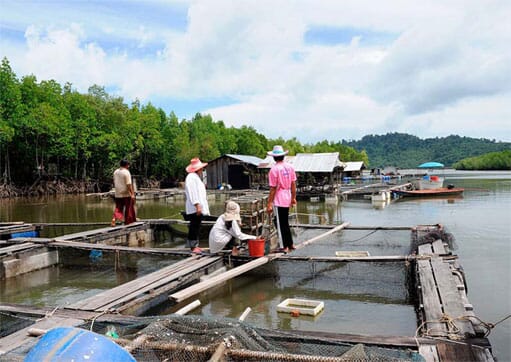
The preferred size for stocking in cages in Thailand is over 10 cm since mortality is reasonably low. Therefore, it is necessary to nurse both hatchery bred and wild caught fingerling (1-2.5 cm) in small net cages (1x1x1.5 m3), earthen ponds (800-1,600 m2) and concrete tanks (5-10 ton) in smallscale (backyard) hatcheries prior to stocking in cages.
There are two types of fish cages including stationary (mainly for seabass) which is suitable for shallow water, not deeper than 2.5 m along the river, canal and lake with less than 1 metre tidal fluctuation, and floating which is commonly located in deeper water of coastal area.
Stationary net cages are anchored at four corners by wooden or bamboo poles and is not movable. Floating cages located at the mouth of rivers and canals use low cost materials such as wooden or bamboo poles for the frame while cages in open water use wooden board or steel frame. Polyurethane foam covered by mosquito net is more common for making float of cage than plastic drum due to its lower cost.
Table 4. Summary of marine fish cage culture practices in Indonesia (SD - stocking density; HS - harvest size; CP - culture period; FGP - farm gate price).

Table 5. Summary of procedures adopted in nursing of marine fish fingerling to juvenile in Thailand.
Table 6. Summary practices of marine fish cage culture in Thailand (SD - stocking density; HS - harvest size; CP - culture period; FGP - farm gate price).

Locally developed commercial floating pellets including CP, Thai Union, Chaipatana, etc, are used for grow out of some of marine fish species and are available at US$ 1.2-1.4/ kg but farmers still believe that growth performance and profit margins are not as good as feeding with trash fish / low valued fish (US$ 0.30-0.40/kg). Trash fish are usually chopped by machine to save labour cost. There are many problems in grouper culture including lack of a reliable seed supply, disease outbreaks, and high investment for improving cage structure, lack of trash fish, good pellet and export market.
Culture practices in Viet Nam
Viet Nam has the potential to significantly increase the development of the marine fish-culture industry due to the strong export market. The total finfish aquaculture production from cages was over 6,500 tonnes in 2007. The main areas for cage culture production in 2007 was in the north, e.g. Quang Ninh Province (4,200 tonnes from 9,000 farms) and Hai Phong (1,900 tonnes from 7,280 farms). There were more than 40,000 cages which mainly farmed lobster and also produced marine fish, more than 1,000 tonnes in Khan Hoa and nearby provinces in central and southern Viet Nam. The main marine finfish species used in cage culture are orangespotted grouper, tiger grouper, green or greasy grouper (E. tauvina), glass-eyed perch (Psammopeca waigiensis), seabream, cobia, red snapper, seabass, pompano and red drum (Scianops ocellatus), and seed stocks are obtained from both government and private hatcheries. There has been considerable investment in hatcheries, particularly by the government and enterprises from Taiwan Province of China, from where fertilised eggs at early stages of development are usually imported. The cultured species that are still dependent on wild caught fry include Malabar grouper, dusky-tail grouper, areolate grouper, Hong Kong grouper, yellow grouper (E. awoara), crimson snapper (L. erythropterus), red snapper and rabbit fish (Siganus spp.). Wild caught fingerlings are also exported by boat to China (including the mainland, Hong Kong, Taiwan Province of China and Hainan Island) but the quantities have gradually decreased.
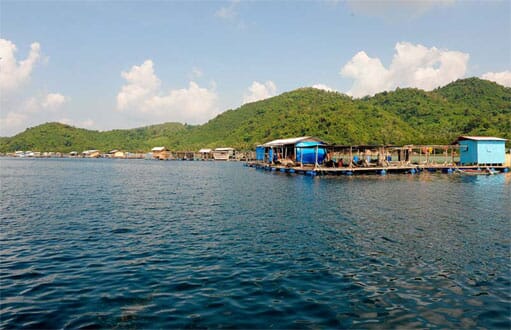
Most cage farms are located in fishing villages where they can easily obtain, relatively cheap supplies of fresh trash / low valued fish. Large-scale Norwegian circular cages for cobia using imported feed from Canada (EWOS) and Chile (BioMar) have been developed in Nha Trang and followed by locally developed large cages in Nghe An and Vung Tau. The fry were originally imported from Taiwan Province of China and later produced locally. However, cobia culture is encountering problems with low prices and limited markets. Although Viet Nam has more than 30 feed mills producing a substantial amount of feeds for aquaculture there is no domestic production for feed for marine finfish. Therefore, most of feeds are imported from Norway (EWOS) for cobia and grouper, from Thailand (CP) for seabass and Taiwan PC for cobia and grouper. More than 90per cent of marine fish farms still use trash fish (US$ 0.4-0.5/kg) caught by small fishers and delivered to cages daily by boat as fresh feed and moist feed.
There are still several constraints including hatchery development, nursery technologies, feed development, disease control, health management and market expansion impeding mariculture development in Vietnam. As more than one million tonnes of trash fish is currently used as direct feed in aquaculture in Viet Nam, it is urgently needed to develop artificial feed to prevent the shortage of trash fish in the future.
Markets for marine fish
Live food fish trade in Asia is still very much a growing sector due to the boom in tourism, improved incomes, improving transportation means and strong and traditional preference for live and fresh fish. Reduction in retail prices brought about by the increase in aquaculture productions also attracts more consumers. Over 10,000 tonnes of high valued live marine fish were imported both by air and sea from Australia, China, Indonesia, Malaysia, Philippines, Taiwan Province of China, Thailand, Viet Nam and Maldives to the largest market in Hong Kong which is also an important distribution centre to China.
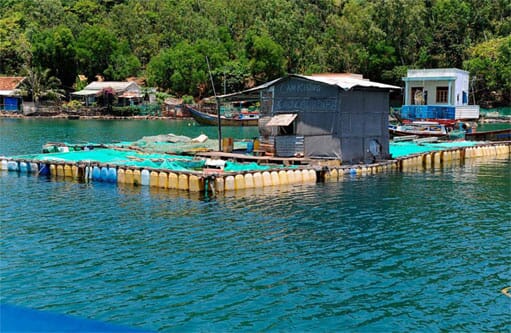
China is the largest producer and consumer of marine fish in the world. In line with the country’s rapid economic development, the market demand for marine fish in China is very high, especially the demand for live high valued species, catering to the live food fish restaurant trade. Directly imported high value live coral reef fish or brought in via Hong Kong are mainly targeted for high-end seafood restaurants in major cities such as Shanghai, Guangzhou and Beijing. The world’s largest wholesale markets in Shanghai and Guangzhou play an important role in distribution of seafood throughout the country. Marine fish are transported both by air and by land. China is also the largest live fish exporter in the world, particularly finfish (seabream, basses, grouper) and eel to Japan, Hong Kong, Korea and Macau.
In Indonesia, the regional trade of adult fish and fingerling is considered to be economically important, particularly its exports to Taiwan Province of China, Hong Kong and Singapore both by boat and by air. The major species for export include leopard coral trout, humpback grouper, tiger grouper and orange spotted grouper. Domestic consumption of live fish is not much but it is improving, particulary in Bali, Jakarta, Yogyakarta, Medan and Surabaya.
In Thailand, seabass market is mainly live and chilled forms for local consumption and is exported to Singapore and Malaysia by land but live grouper is mainly exported only by air to Hong Kong, Taiwan Province of China and mainland China. Export species include orange spotted grouper, tiger grouper and leopard coral trout. However, Hong Kong considers Thai grouper as low grade product (pale color and muddy taste) due to their culture in low saline water or mangrove creeks. Shipment by air also burdens the cost for Thai exporters as they cannot compete with fish transported by sea from Viet Nam, Taiwan Province of China or even Indonesia. Thailand used to export millions of hatchery bred seabass and wild caught grouper fry to Hong Kong, China (through Hong Kong) and Taiwan Province of China. Since they have been successfully bred and mass cultured in those importing countries, it was not necessary to import both fry and adult fish from Thailand anymore. Though there are few problems on hatchery and culture practice, seabass culture still faces major constraints due to the lack of export markets of both live and frozen fish. Farmers also consider not be economically profitable to grow large size seabass (1.5-3.0 kg) for export of frozen fillets due to stunting on reaching 1.0 kg.
Table 7. Summary practices of marine fish cage culture in Viet Nam (SD - stocking density; CP - culture period; HS - harvest size; FGP - farm gate price).

A strong export market is the driving force for the growth in aquaculture in Viet Nam. Exported species include orange spotted grouper, greasy grouper, areolate grouper and Malabar grouper. Because of Vietnam’s relative proximity to large markets in Hong Kong, Taiwan Province of China, Hainan and western / southern China, live fish are mainly traded by boats which is more cost effective, and commands a decisive advantage over other ASEAN countries. There is also a growing demand of live or chilled fish in the domestic market as personal income have been improved substantially over the years after Viet Nam has adopted market economy.
To expand marine fish as a global commodity to the huge frozen market in other regions, it is necessary to develop suitable species, particularly fast growing and low production cost species in order to produce fillet or frozen whole fish which yield lower price than live or fresh fish, similar to salmon, tilapia, catfish and shrimp. Cobia and giant grouper are the candidates but it is necessary to lower the feed cost and to promote them in international markets, particularly in US and EU supermarkets and in restaurant chains. Meanwhile, governments and relevant authorities should also promote domestic consumption similar to the success of Penaeus vannamei in China and Thailand. Though the profit margin of the domestic market is smaller it is more s than export markets, which always encounter problems of competition in production and price fluctuations due to extraordinary events.

